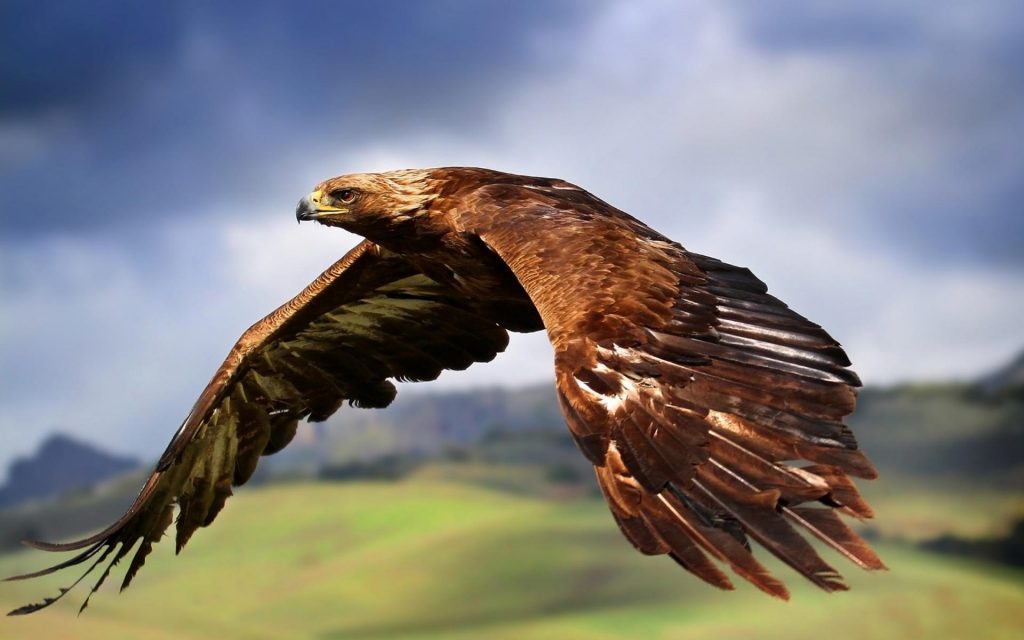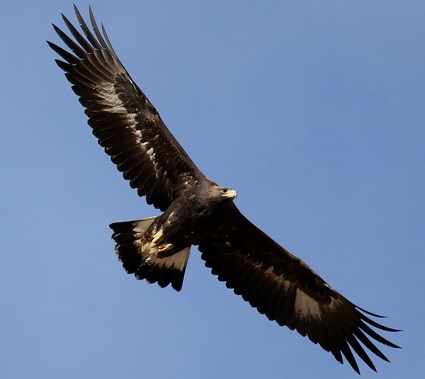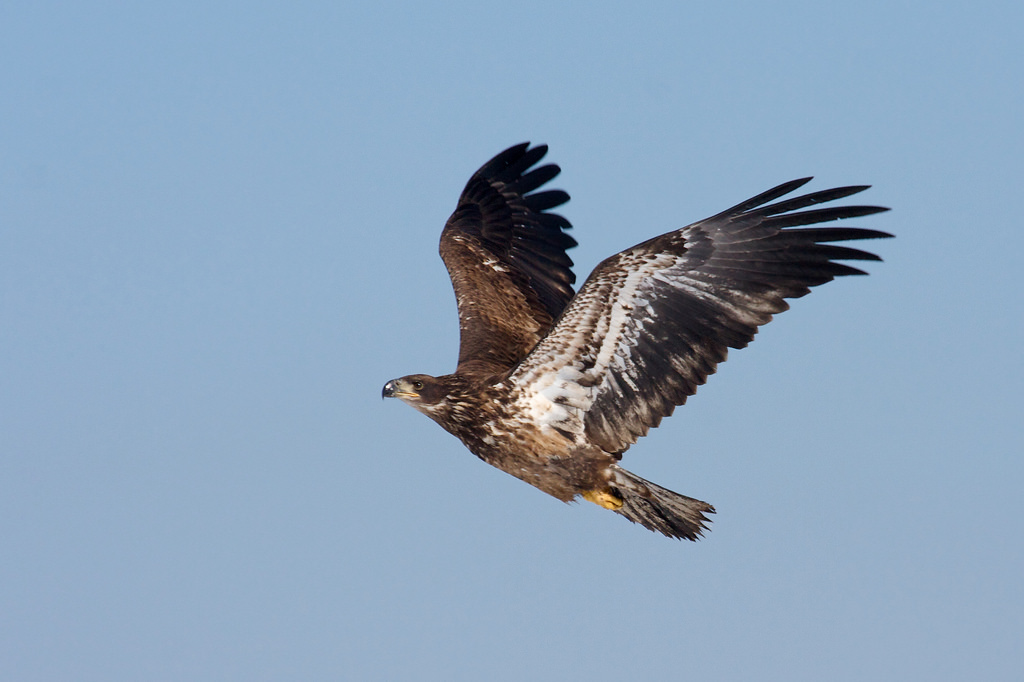
Figure 1.) Golden Eagle in flight (Retrieved from zooaroundtheworld.wordpress.com)
The golden eagle is one of the world’s most distinguished bird species, and for good reason. As early as there has been written history, there have been stories about the golden eagle; from written character in Egyptian hieroglyphics, to the Ancient Greeks who believed that the golden eagle was the messenger of the gods (Sandiego Zoo, 2011). Today, the golden eagle is the national bird of Mexico, originally being heralded as the sun god Huitzilopochtli in ancient Aztec culture (Rancho Las Cascadas, 2017).
Golden eagles are North America’s largest raptor, with wings spans ranging up to 2.5m and weighing as much as 7 kilograms (Nat Geo, 2017). They typically have dark brown bodies, and a distinctive “golden” colouration on the back of their head and neck giving them their name (Fig 1). Juvenile golden eagles such as in figure 2 can be distinguished by the white patches on the underside of their wings and base of tail. Juvenile bald eagles are often misidentified as golden eagles due to their similar brown colourations and white wing undersides (Fig 2). Juvenile bald eagles however typically have distinct white armpits, allowing for their distinction (Fig 3) (Cornell University: All About Birds).

Figure 2.) Soaring Juvenile Golden Eagle showing distinctive white wing underside and tail base (Photo by Hawk Person)

Figure 3.) Flying Juvenile Bald Eagle showing distinguishing white armpits (Photo by Michael J. Andersen)
The distribution of golden eagles is vast, Stretching along most of the northern hemisphere. They can be found roaming North America, Eurasia, northern Africa, and many parts of Asia. In North America, golden eagles are more frequently seen in the west, while lower populations observed in eastern areas (Nat Geo, 2017). One reason for this may be due to the golden eagles preferring habitats away from human activity, which is more easily accomplished in western Canada. They will exploit a range of different habitats, from from the arctic tundra to coniferous forests, farmland, or even deserts (Cornell University: All About Birds). Their favoured terrain however appears to be mountainous alpine or sub-alpine areas nearby to open habitats such as grasslands. In British Columbia the most likely area for sighting golden eagles is in the Southern Interior Mountains where clusters of birds may occasionally be observed (Starzomski, 2015).

Probability of observing golden eagles in areas of British Columbia (Bird Atlas)
Like many birds, many golden eagles will undergo a incredible migration, spanning thousands of kilometers each fall to southern wintering grounds. However, typical wintering grounds in North America extend from southern British Columbia to Mexico. These wintering grounds result in the migration of northern populations of golden eagles, while most of the southern populations will stay year-round. Mating season begins early spring for most golden eagles, where territories as large as 20-30 square kilometers are typically occupied. Within the territory mates will maintain up to 14 nests as part of their courtship (Birds of North America, 2002). Golden eagles are monogamous, typically reproducing with a single mate for many years once paired. A female will typically lay up to four eggs a year, which are incubated for 6 weeks before hatching. On average only one egg will hatch and survive to fledging before leaving the parents in the fall. Once independent it will take around 4 to 5 years before the eagle will lose its juvenile colouration and begin to set up its own territory (Zoo around the World, Steenhof et al, 2017).
One of the most astounding aspects of the golden eagle is its feeding habits. Like most animals they follow a optimum feeding diet, where the costs and benefits of different prey are taken into account when choosing prey. Typically prey will be different species of rabbits, hares, or squirrels however under certain conditions extremes may occur. The video below shows an extreme in hunting, where a golden eagle kills a prey item much larger then itself by a relatively unique process. By knocking sheep, goats, deer or other prey items off high ledges they can be rewarded by an abundance of food. This technique however includes a large risk, as there is also a significant chance of injury to the bird. (Bedrosian et al, 2017).
1) Bedrosian et al. spatial and temporal patterns in golden eagle diets in the western united states, with implications for conservation planning. Journal of Raptor Research. 2017. 51(3), 347-367.
2) Golden Eagle, Aquila chrysaetos. San Diego Zoo Global. http://library.sandiegozoo.org/factsheets/golden_eagle/golden_eagle.htm [10 Nov 2017]
3) Golden Eagle. All About Birds. Cornell University https://www.allaboutbirds.org/guide/Golden_Eagle/id [10 Nov 2017]
4) Golden Eagle. National Geographic Animals. https://www.nationalgeographic.com/animals/birds/g/golden-eagle/ [10 Nov 2017]
5) The golden eagle: national bird of Mexico. Rancho La Cascades. http://rancholascascadas.com/the-golden-eagle-national-bird-of-mexico/ [10 Nov 2017]
6) Golden Eagle. Zoo around the world. https://zooaroundtheworld.wordpress.com/europe/golden-eagle/ [10 Nov 2017]
7) Kochert, M. N., Karen Steenhof, C. L. McIntyre and E. H. Craig. Golden Eagle (Aquila chrysaetos), version 2.0. In The Birds of North America (P. G. Rodewald, editor). Cornell Lab of Ornithology, Ithaca, New York, USA. 2002. https://doi.org/10.2173/bna.684 [10 Nov 2017]
8) Starzomski, B. Golden Eagle in Davidson, P.J.A., R.J. Cannings, A.R. Couturier, D. Lepage, and C.M. Di Corrado (eds.). The Atlas of the Breeding Birds of British Columbia, 2008-2012. Bird Studies Canada. Delta, B.C. 2015. http://www.birdatlas.bc.ca/accounts/speciesaccount.jsp?sp=GOEA&lang=en [10 Nov 2017]
9) Steenhof, K., Kochert, M., McIntyre, C., & Brown, J. coming to terms about describing golden eagle reproduction. Journal of Raptor Research. 2017. 51(3), 378-390.
Great blog post Evan! Golden eagles are quite the interesting birds. That’s crazy they will try and take out an animal as large as a goat! It’s also very fascinating that a golden eagle will lay up to 4 eggs, but only one will fledge. In my animal behaviour class I remember reading that out of 200 records from black eagles nests where both chicks hatched, there was only one case where the two chicks fledged! Do you know why this happens?
Thanks Paige, I believe its mostly due to the cost of supplying food for the chicks. For large eagles they require both a long amount of time to fledge (~6weeks) as well as a large amount of food during this development. This makes it very difficult to give a constant supply of food for multiple chicks for multiple chicks to survive, with the dominant chick typically only surviving.